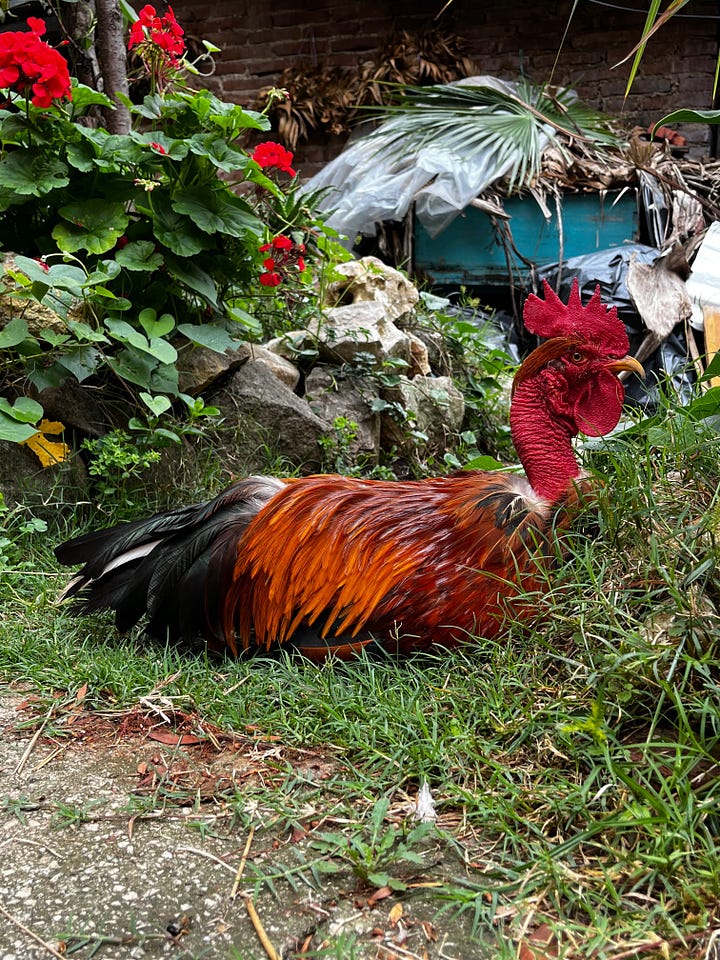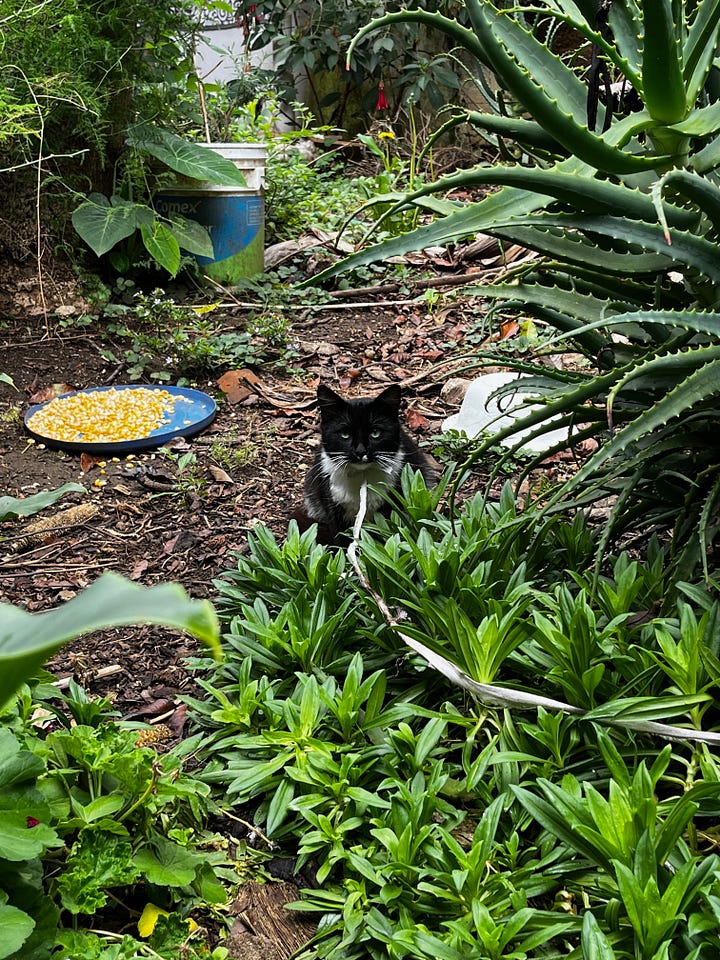“Es que es de primer mundo,” Javier chuckles, making fun of me. Dunking the mesh frame into the cold, rationed water over and over again brings my frustration to the surface. Bugambilia flower pulp swirls beneath me. Javier’s words sting a little because they are true. It scares me to realize how noxious and subtle the addiction to convenience is. It shames me to belong to a part of the world that has a deeply distorted sense of time.
I pick the bugambilia flowers in silence, noticing my own impatience. I try to discover tricks to pull the flower apart faster, but stamen pieces keep falling into my pile of petals. Instead, I discover my tendency to rush—my inability to stay focused.
Bugambilia becomes my guru. Javier simply puts sound to their wordless teaching: Sloooooooooooooowwwwwwwwwwwww ddddoooooooooooooooowwwwwwnnnnnn, pluck, pluck, pluck, waaaaaaaaaaaaaay doooooooooooooooooooowwwwnnnnnnn, pluck, pluck, pluck, pluck. Making paper becomes a meditation. Making paper becomes a way of returning to a wordless part of myself. Making paper becomes a poem. Drip drip drip drip.
Everywhere I walk, I begin to notice bugambilia. This has happened to me before. 1Certain plants capture my whole attention until I figure out what they are trying to say to me. In the past, this sensation has felt urgent, inevitable, even slightly frightening, but I’m growing more used to it with time. Bugambilia and Pensamiento are the flowers I have recently learned from.
After this first day of paper-making, I now have a name for the flowers outside my window—bugambilia. I now have more context for every time I stop to admire the way they bring life to the streets, ignoring the walls of the city—bugambilia! One night, I open a copy of Laberinto de la Soledad by Octavio Paz, and bugambilia appears there too:
“¿Cómo quieres que me gusten las flores si no conozco su nombre verdadero, su nombre inglés, un nombre que se ha fundido ya a los colores y a los pétalos, un nombre que ya es la cosa misma? Si yo digo bugambilia, tú piensas en las que has visto en tu pueblo, trepando un fresno, moradas, y litúrgica, o sobre un muro, cierta tarde, bajo una luz plateada, y la bugambilia forma parte de tu ser, es una parte de tu cultura, es eso que recuerdas después de haberlo olvidado. Esto es muy hermoso, pero no es mío, porque los que dicen el ciruelo y los eucaliptos no lo dicen para mí, ni a mí me lo dicen.”
This passage is the inverse of my experience. Here, Octavio Paz quotes his Mexican friend who relocated to Berkeley, California. I am an American in Mexico. I might have a Mexican passport, but that doesn’t take away the fact that bugambilia was a stranger to me before this trip. The flower confronts me with the ongoing question of who am I? My neighbor, an expat from London, asks me if I think in Spanish or English, and I don’t know how to answer him—it depends on what I’m thinking about. “English predominantly,” I answered him. Afif, my landlord, overhears the question, laughs, and says, “Only Americans use the word ‘predominantly’!” Moments like this make me feel trapped in a web of incomprehensibility. I find it ironic that language is where I find the most solace, and yet language has always been my greatest tormentor. “The limits of my language mean the limits of my world,” said Wittgenstein, and I find myself at a new edge of what I can comprehend. Neither the word nor the flower, bugambilia, belongs to me, and I make peace with this.
I move on to make paper with Pensamiento next. The English word for this flower, pansy, feels wrong and it bothers me. Pansy—“a man who is seen as unmasculine, timid, or affected.” Pensamiento—a thought. One afternoon, an Italian family tours the workshop while we are making paper, and they ask about the flowers. I tell them the English name—pansy—and I feel like I’m lying to them. Lying and being wrong are the same thing. I ask Javier why they are named Pensamiento, and he tells me they can hear lovers' thoughts, but I think he just made that up on the spot. Either way, I became enamored with both the flower’s name and its properties. In sunlight, Pensamiento shifts the color of the paper. “Está vivo,” Javier tells me. It’s alive. The flower creates a blown-glass look that I really like, and the dark blues and greens evoke a sense of being lost in thought.
Carmen, a 21-year-old Tzeltal woman, is my main paper teacher. She begins to ask me how to say bad words in English, and I agree as long as she teaches me some Tzeltal. She asks how to say “chinga tu madre perra,” which I translate as “motherfucking bitch.” She teaches me how to say “I am leaving now. Goodbye,” which becomes hard to say when the day finally comes for me to leave Taller Leñateros.
When I first walked into the studio, Javier sat me down and asked what I could reciprocate in exchange for lessons. He didn’t ask for money right away, and that’s how I knew he was a real teacher. He made it clear that only gente de pueblos originarios would ever hold keys to the space, which convinced me even further of the value of what was happening there. “We don’t consider ourselves artists,” he told me, “we prefer to think of ourselves as artistic workers,” and somehow this made perfect sense to me because I also don’t think of myself as an artist.
To me, Taller Leñateros represents a piece in the city where the environment and cultural practice harmonize. There is no division between these worlds here and that’s what I love most about this place. At Taller Leñateros, I am taught to minimize my consumption of resources in every decision I make. For instance, the first coptic stitch book I am allowed to make, Javier doesn’t allow me to use the power drill to make the holes on the spine. He hands me a mallet (there is no hammer) and a nail, and has me learn this way first. “Do you have a drill at home? No, well then you have to learn like this.” This takes me over an hour, which I find annoying, but like usual there’s another meaning to his instruction: with any craft, one has to persevere in spite of material constraints.
On the last day at the shop, I assemble my final book. The rooster, Pancho, gets into a fight with the kitten, Tommy (I’ve grown especially fond of Tommy because he reminds me of my own cat, Mixi). I break the two up. They have become my friends over the last few weeks. Pancho now comes near me and Tommy lets me pick him up. I pack my paper and books.


I keep stalling on my departure. I walk to the bakery and bring back bread for us all to share. I finally manage to walk out the front gate with my little box of books, knowing that the physical objects I created here are mere byproducts of the actual lessons I learned. I’m unsure of exactly when I’ll return to Taller Leñateros, but I feel certain that someday, God willing, I will.
PLAYLIST—a glimpse at all the emotions I experienced while in Chiapas. The song “Cabras” by Little Jesus and Jimena Gonzales on there has a line about Bugambilia. I listened to “Grease” by Frankie Valli obsessively on loop for like four days straight.
Iphone notes poem I wrote quickly that mentions Bugambilia:
PABLO NERUDA POEMA 15, my yoga teacher read this to us in the Huitepec forest after a silent meditation. No mention of bugambilia, but it made me realize how beautiful silence, especially shared silence, is.
GRACIAS POR LEER, I LUV YOU <3
The first time this happened was with Wachuma a.k.a San Pedro in Cusco, Peru when I was 21 years old. On this trip I experienced food poisoning, and after a day of involuntary fasting and purging, Wachuma kept presenting itself to me. Notice me, notice me, notice me, it seemed to say. The cactus seemed to be everywhere I went, and I began to feel paranoid and thought I was going crazy. For instance, one day I decided to walk as far as I could and ended up at a random market, and sure enough it was a San Pedro market. Nearly all the shops there sold the cactus in powder for consumption. I bought a dose of dried powder, but never took it. I was heartbroken at the time and didn’t feel physically, mentally or spiritually strong enough to trip. They say the cactus has the paternal energy and helps heal the heart. I have never consumed San Pedro, but I do believe I welcomed it into my heart. This experience taught me to begin relating to plants as friends, as companions, as guardians. Wachuma still follows me today, as a sign post to let me know everything's alright, that I am protected and on the right path.
This happened again with another cactus–Hikuri (Peyote). In Denver, I was gifted seeds and so I planted them. Once sprouted, the little baby buttons began visiting me in dreams. Both these powerful cacti, whom I have never ingested yet hold deep reverence for, have taught me that it is not necessary to consume plants to learn from them. In fact, sometimes there is more to learn from plants through quiet, patient observation (listening).









